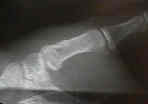- See: Metacarpal Extra-articular Base Frx
- Discussion:
- oblique and comminuted frx predispose to shortening and malrotation;
- displacing forces:
- these frxs are displaced by tendons inserting into each fragment;
- distal metacarpal fragment is flexed into palm by pull of thenar muscles and adducted by adductor pollicis;
- adductor deformity narrows the thumb web space and results in a decreased span of grasp which may limit pinch and grip strength;
- proximal fragment is extened & abducted by abductor pollicis longus;
- Radiographs:
- must r/o intra-articular frx;
- epibasal oblique frx may be confused w/ Bennett's frx;
- tomograms may be required to define any articular involvment;
- Non Operative Rx:
- do not over treat these fractures - usually heals w/ closed reduction;
- up to 20 to 30 deg of angulation (typically adduction deformity), is well tolerated, since trapeziometacarpal joint is mobile;
- distal fragment is manipulated to effect & maintain reduction;
- avoid hyperextension of the thumb MP joint;
- thumb is immobilized in spica for 4 to 6 weeks;
- Indications for Surgery:
- angulation is > 30 deg: use closed reduction & percutaneous K wire;
- Technique:
- one K wire is driven down medullary canal of thumb metacarpal and is passed into the trapezium:
- second K wire is driven across the proximal thumb fracture fragment and is then passed into the base of the index metacarpal;
- Case Example:
- 20 year old male who sustained extra-articular basal frx of thumb;
- on AP and Oblique views the displacement is not impressive;
- on a true lateral view, however, the indication for surgery is apparent;






